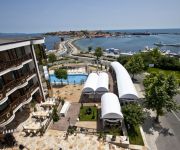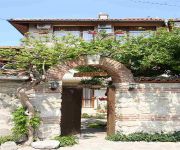Facts and Data
Webpages:
Official Unesco Page
Basis Data:
Unesco World heritage since: 1983
Size of heritage: 27 ha
- Buffer zone: 1,246 ha
Coordinates:
Longitude: 27,730°
Latitude: 42,656°
Summary
Situated on a rocky peninsula on the Black Sea, the more than 3,000-year-old site of Nessebar was originally a Thracian settlement (Menebria). At the beginning of the 6th century BC, the city became a Greek colony. The city’s remains, which date mostly from the Hellenistic period, include the acropolis, a temple of Apollo, an agora and a wall from the Thracian fortifications. Among other monuments, the Stara Mitropolia Basilica and the fortress date from the Middle Ages, when this was one of the most important Byzantine towns on the west coast of the Black Sea. Wooden houses built in the 19th century are typical of the Black Sea architecture of the period.
Location on Map
Show bigger map on Openstreetmap
Introduction
The Ancient City of Nessebar, located in the Burgas Province of Bulgaria, is a UNESCO World Heritage site renowned for its rich history and well-preserved architectural treasures. This ancient city, situated on a small peninsula in the Black Sea, has witnessed the rise and fall of numerous civilizations over the centuries, leaving behind a remarkable cultural legacy.History
The history of Nessebar dates back over three millennia, with evidence of Thracian settlements as early as the 2nd millennium BC. Throughout its existence, the city has been under the rule of various empires, including the Greeks, Romans, Byzantines, and Ottomans. Each civilization has left its mark on the city's architecture, resulting in a unique blend of styles. During the 6th century BC, Nessebar became a Greek colony known as Mesembria. It flourished as a trading center and played a significant role in the region's economy. The city's strategic location made it a coveted prize for many empires, leading to numerous invasions and conquests. The Byzantine Empire exerted its influence over Nessebar during the 5th century AD, transforming it into a major religious and cultural center. The city became home to numerous churches and monasteries, many of which still stand today. The Byzantine era marked a period of prosperity and artistic development for Nessebar. In the 14th century, the city fell under Ottoman rule, which lasted for nearly five centuries. During this time, Nessebar experienced a decline in its economic and cultural significance. However, the Ottoman influence is still visible in some of the city's architectural elements.Current State
Today, the Ancient City of Nessebar stands as a testament to its rich history and cultural heritage. The city's well-preserved architecture showcases a harmonious blend of ancient Greek, Roman, Byzantine, and Ottoman styles. The city is home to numerous churches, each with its unique architectural features. The Church of St. Stephen, dating back to the 11th century, is a prime example of Byzantine architecture, with its intricate frescoes and ornate decorations. The Church of Christ Pantocrator, built in the 13th century, exhibits a fusion of Byzantine and Bulgarian architectural styles. In addition to its religious buildings, Nessebar boasts a wealth of other historical sites. The Ancient Theater, constructed during the Roman era, once hosted various performances and still stands as a testament to the city's cultural significance. The city walls, dating back to the 5th century BC, offer panoramic views of the Black Sea and the surrounding landscape. Nessebar's historical significance and architectural beauty have made it a popular tourist destination. The city attracts visitors from around the world who come to explore its ancient streets, admire its well-preserved buildings, and immerse themselves in its rich cultural heritage. Efforts have been made to preserve and protect the Ancient City of Nessebar. The site was inscribed as a UNESCO World Heritage site in 1983, ensuring its safeguarding for future generations. Conservation projects and strict regulations have been implemented to maintain the city's authenticity and prevent any further deterioration. In conclusion, the Ancient City of Nessebar in Bulgaria's Burgas Province is a remarkable UNESCO World Heritage site that showcases the city's rich history and architectural treasures. From its ancient Greek and Roman roots to its Byzantine and Ottoman influences, Nessebar stands as a living testament to the civilizations that have shaped it over the centuries. Its well-preserved churches, theaters, and city walls offer visitors a glimpse into the past, making it a must-visit destination for history and culture enthusiasts.Hotels and places to stay
SOL Nessebar Bay
Sol Marina Palace
The Mill Boutique Hotel
Trinity Sea Residence Nessebar
Kirios
Italia
THE MILL HOTEL MELNICATA NESEBAR
FAVORIT HOTEL BURGAS
STELA HOTEL NESEBAR
GUEST HOUSE MLINO BLED
Videos from the area
Videos provided by Youtube are under the copyright of their owners.














